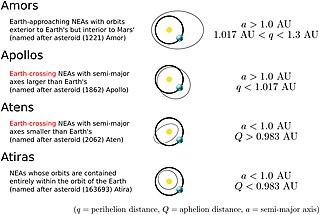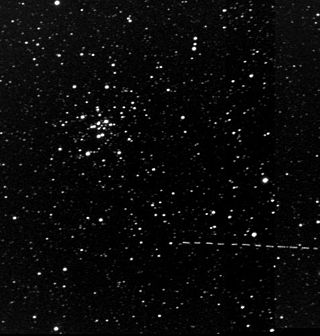Related Research Articles
2003 YN107 is a tiny asteroid, classified as a near-Earth object of the Aten group moving in a 1:1 mean-motion resonance with Earth. Because of that, it is in a co-orbital configuration relative to Earth.

Atira asteroids or Apohele asteroids, also known as interior-Earth objects (IEOs), are Near-Earth objects whose orbits are entirely confined within Earth's orbit; that is, their orbit has an aphelion smaller than Earth's perihelion, which is 0.983 astronomical units (AU). Atira asteroids are by far the least numerous group of near-Earth objects, compared to the more populous Aten, Apollo and Amor asteroids.
(99907) 1989 VA is a very eccentric, stony asteroid and near-Earth object, approximately 1 kilometer in diameter. It was discovered on 2 November 1989, by American astronomer couple Carolyn and Eugene Shoemaker and Canadian astronomer David Levy at the Palomar Observatory on Mount Palomar, California.

(33342) 1998 WT24 is a bright, sub-kilometer asteroid, classified as near-Earth object and potentially hazardous asteroid (PHA) of the Aten group, located in Venus's zone of influence that has frequent close encounters with Mercury, Venus, and Earth. It made a close approach to Earth on 11 December 2015, passing at a distance of about 4.2 million kilometers (2.6 million miles, 11 lunar distances) and reaching about apparent magnitude 11.

524522 Zoozve (provisional designation 2002 VE68) is a sub-kilometer sized asteroid and temporary quasi-satellite of Venus. Discovered in 2002, it was the first such object to be discovered around a major planet in the Solar System. In a frame of reference rotating with Venus, it appears to travel around it during one Venerean year, but it orbits the Sun, not Venus.
(322756) 2001 CK32 is a sub-kilometer asteroid and near-Earth object of the Aten group. It is also a transient Venus co-orbital, and a Mercury grazer as well as an Earth crosser. It was once designated as a potentially hazardous asteroid.
2013 BS45 (also written 2013 BS45) is a horseshoe companion to the Earth like 3753 Cruithne. Like Cruithne, it does not orbit the Earth in the normal sense and at times it is on the other side of the Sun, yet it still periodically comes nearer to the Earth in sort of halo orbit before again drifting away. While not a traditional natural satellite, it does not quite have normal heliocentric orbit either and these are sometimes called quasi-satellties or horseshoe orbits.
2012 FC71, also written 2012 FC71, is a small asteroid trapped in a Kozai resonance with the Earth.
2013 ND15 (also written 2013 ND15) is an asteroid that is a temporary trojan of Venus, the first known Venus trojan.
2014 OL339 (also written 2014 OL339) is an Aten asteroid that is a temporary quasi-satellite of Earth, the fourth known Earth quasi-satellite.
2013 LX28, is an asteroid, classified as near-Earth object of the Apollo group that is a temporary quasi-satellite of the Earth, the third known Earth quasi-satellite.
2015 SO2 (also written 2015 SO2) is an Aten asteroid that is a temporary horseshoe companion to the Earth, the ninth known Earth horseshoe librator. Prior to its most recent close encounter with our planet (2015 September 30) it was an Apollo asteroid.
2015 XX169 (also written 2015 XX169) is an Apollo asteroid that is a temporary horseshoe companion to the Earth, the tenth known Earth horseshoe librator. A close encounter with the Earth on 14 December 2015 caused the value of the semi-major axis of 2015 XX169 to drift slowly upwards, and the object evolved from an Aten asteroid to an Apollo asteroid about a year after this close approach.
2015 YQ1 (also written 2015 YQ1) is an Apollo asteroid that is a temporary horseshoe companion to the Earth, the twelfth known Earth horseshoe librator. It experienced a close encounter with the Earth on 2015 December 22 at 0.0037 AU.
2015 YA is a sub-kilometer asteroid, classified as near-Earth object of the Aten group, that is a temporary horseshoe companion to the Earth. It is the 11th known Earth horseshoe librator. Prior to a close encounter with the Earth on 15 December 2015, 2015 YA was an Apollo asteroid.

594913 ꞌAylóꞌchaxnim (provisional designation 2020 AV2) is a large near-Earth asteroid discovered by the Zwicky Transient Facility on 4 January 2020. It is the first asteroid discovered to have an orbit completely within Venus's orbit, and is thus the first and only known member of the eponymous ꞌAylóꞌchaxnim (informally named Vatira before its discovery) population of Atira-class asteroids. ꞌAylóꞌchaxnim has the smallest known aphelion and third-smallest known semi-major axis among all asteroids. With an absolute magnitude approximately 16.2, the asteroid is expected to be larger than 1 km in diameter.

2011 SP189 is a small asteroid and Mars trojan orbiting near the L5 point of Mars (60 degrees behind Mars on its orbit).
2020 VT1 is a small asteroid, classified as a near-Earth object of the Amor group, that is a temporary horseshoe companion to Mars.
2020 PN1 is a sub-kilometer asteroid, classified as a near-Earth object of the Aten group, that is a temporary horseshoe companion to the Earth. There are dozens of known Earth horseshoe librators, some of which switch periodically between the quasi-satellite and the horseshoe co-orbital states.
2020 PP1 is a sub-kilometer asteroid, classified as a near-Earth object of the Apollo group, that is a temporary quasi-satellite of the Earth. There are over a dozen known Earth quasi-satellites, some of which switch periodically between the quasi-satellite and horseshoe co-orbital states.
References
- ↑ List Of Aten Minor Planets
- 1 2 3 "2012 XE133". JPL Small-Body Database . Jet Propulsion Laboratory. SPK-ID: 3620867 . Retrieved 3 April 2016.
- ↑ "Asteroid Size Estimator". CNEOS NASA/JPL. Retrieved 16 February 2018.
- 1 2 3 4 de la Fuente Marcos, C.; de la Fuente Marcos, R. (2013). "Asteroid 2012 XE133, a transient companion to Venus". Monthly Notices of the Royal Astronomical Society . 432 (2): 886–893. arXiv: 1303.3705 . Bibcode:2013MNRAS.432..886D. doi:10.1093/mnras/stt454.
- Further reading
- Understanding the Distribution of Near-Earth Asteroids Bottke, W. F., Jedicke, R., Morbidelli, A., Petit, J.-M., Gladman, B. 2000, Science, Vol. 288, Issue 5474, pp. 2190–2194.
- A Numerical Survey of Transient Co-orbitals of the Terrestrial Planets Christou, A. A. 2000, Icarus, Vol. 144, Issue 1, pp. 1–20.
- Debiased Orbital and Absolute Magnitude Distribution of the Near-Earth Objects Bottke, W. F., Morbidelli, A., Jedicke, R., Petit, J.-M., Levison, H. F., Michel, P., Metcalfe, T. S. 2002, Icarus, Vol. 156, Issue 2, pp. 399–433.
- Transient co-orbital asteroids Brasser, R., Innanen, K. A., Connors, M., Veillet, C., Wiegert, P., Mikkola, S., Chodas, P. W. 2004, Icarus, Vol. 171, Issue 1, pp. 102–109.
- The population of Near Earth Asteroids in coorbital motion with Venus Morais, M. H. M., Morbidelli, A. 2006, Icarus, Vol. 185, Issue 1, pp. 29–38.
- Asteroid 2012 XE133: a transient companion to Venus de la Fuente Marcos, C., de la Fuente Marcos, R. 2013, Monthly Notices of the Royal Astronomical Society, Vol. 432, Issue 2, pp. 886–893.
- AstDys-2 on 2012 XE133 Retrieved 2013-02-20